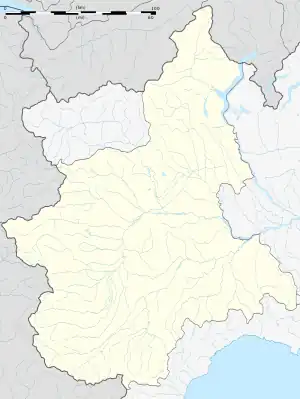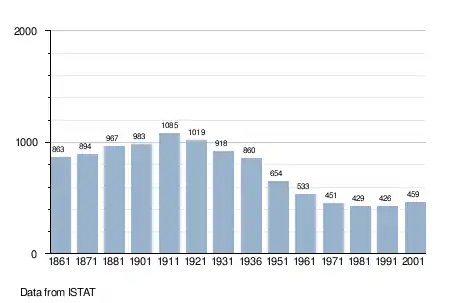Cinaglio | |
|---|---|
| Comune di Cinaglio | |
 Coat of arms | |
Location of Cinaglio | |
 Cinaglio Location of Cinaglio in Italy  Cinaglio Cinaglio (Piedmont) | |
| Coordinates: 44°58′N 8°6′E / 44.967°N 8.100°E | |
| Country | Italy |
| Region | Piedmont |
| Province | Province of Asti (AT) |
| Government | |
| • Mayor | Flavio Miniscalco (L'impegno comune) |
| Area | |
| • Total | 5.4 km2 (2.1 sq mi) |
| Population (Dec. 2019)[2] | |
| • Total | 450 |
| • Density | 83/km2 (220/sq mi) |
| Demonym | Cinagliesi |
| Time zone | UTC+1 (CET) |
| • Summer (DST) | UTC+2 (CEST) |
| Postal code | 14020 |
| Dialing code | 0141 |
| Patron saint | Felix of Valois |
| Saint day | 20 November |
| Website | Official website |
Cinaglio is a comune (municipality) in the Province of Asti in the Italian region Piedmont, located about 35 kilometres (22 mi) southeast of Turin and about 11 kilometres (7 mi) northwest of Asti. As of 31 December 2004, it had a population of 470 and an area of 5.4 square kilometres (2.1 sq mi).[3]
Cinaglio borders the following municipalities: Asti, Camerano Casasco, Chiusano d'Asti, Cortandone, Monale, and Settime.
History
The village today stands on top of a hill, but in ancient times it had to be placed further downstream. The first news of Cinaglio, whose name seems to derive from the Latin cenaculum, in the meaning of "hotel", "inn", ie place of rest on the road connecting Hasta with Industry, date back to Roman times.
In 962 he was assigned to the bishop of Asti by Emperor Otto I.
In 1198, according to the Codex Astensis, Cinaglio is included in the territories subject to Asti and its jurisdiction. It became a free commune in 1383 and was included in the endowment of Valentina Visconti shortly afterwards, under the rule of the Orleans.
The pacts agreed by the Community with the Visconti in 1383 were the basis of the events of the territory for about two centuries.
With the passage of Asti to the Duchy of Savoy (1531), Cinaglio also lost the privileges he had enjoyed under the Visconti. Only in 1560 did it regain the recognition of its franchises, reconfirmed by Charles Emmanuel I in 1587. Being "free land" Cinaglio was not subjected by any feudal lord until the early seventeenth century. In 1619 the county of Chiusano-Cinaglio was established and assigned to the Caissotti family. With the Napoleonic domination it was part of the Tanaro department.
Only after the restoration and the return of Vittorio Emanuele I, the province of Asti was reconstituted, then suppressed with the unification of Italy. From then until 1935, Cinaglio was part of the province of Alessandria.
Symbols
The coat of arms and the banner of the Municipality of Cinaglio were granted by decree of the President of the Republic of 2 December 1998.
Main sights
Among the religious buildings we remember:
- the Parish Church of Saints Felice and Giorgio, baroque building with brick facade
- the ancient Church of San Felice near the cemetery, built in the thirteenth century in Romanesque forms, with exposed brick walls
In the concentric there is the interesting gipsoteca "E. Gonetto", rich collection of chalks of artistic character with copies of masterpieces from antiquity to the modern era. Just outside the center, we find the locality Gorghi very interesting from the naturalistic and paleontological point of view as they were found in the yellow sands, characteristics of the "Astian" period, the fossil remains of marine and terrestrial animals.
In the long walks in the natural park it is not uncommon to meet the hawk, woodpecker, jay and many other wild animals. Part of the territory of the municipality is included in the Special Nature Reserve of the Andona Valley, Botto Valley and Val Grande.
Demographic evolution

Food
The gastronomic specialty is represented by the "canestrelli" packaged in waffles, with a special plate.
Events
During the feast of St. Felice, which is celebrated today on the last Sunday of August, but which originally was the third of November, in the afternoon there is the Canestrello Festival: a gastronomic tournament of the historical recipe. The event sees in 2006 the first re-edition following a suspension lasting about twenty years. All families compete bringing their own recipe of canestrelli in front of a jury of "illustrious" tasters who will conclude the winner of the year by giving the winner a generous cash prize.
References
- ↑ "Superficie di Comuni Province e Regioni italiane al 9 ottobre 2011". Italian National Institute of Statistics. Retrieved 16 March 2019.
- ↑ "Popolazione Residente al 1° Gennaio 2018". Italian National Institute of Statistics. Retrieved 16 March 2019.
- ↑ All demographics and other statistics: Italian statistical institute Istat.
External links